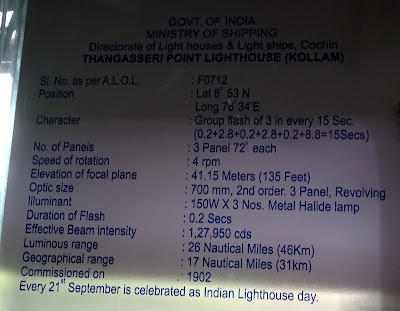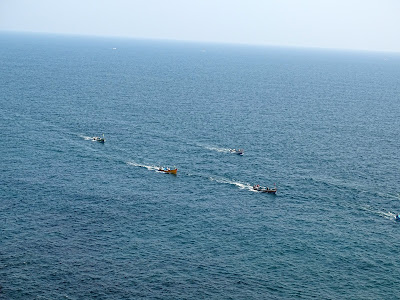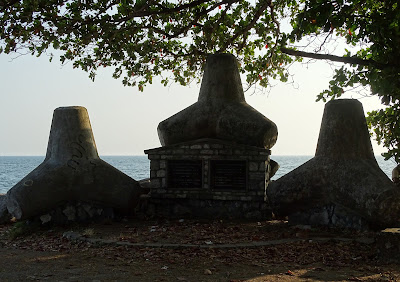I have always been fascinated by Lighthouses and make it a point to visit them, whenever I visit a coastal city with a Lighthouse.
I was quite excited to visit the Thangaserri Light House located at Thangasseri Harbour in Kollam city during the last day of our trip to Ashtmudi (Kerala).
The above information board at the Linghtouse enumerates the necessity of setting up Lighthouses near the shores
This Board gives details of the Thangasseri Point Lighthouse, mentioning inter alia the height of the tower as 135 feet (or 41.15 metres), Speed of rotation at 4 RPM, Luminous Range 26 Nautical Miles (or about 46 kilometres) and Geographical Range 17 Nautical Miles (or about 31 kms)
The logo of the Lighthouses as seen at the Thangasseri Lighthouse
It shows an emblem of the Government of India at the top together with its motto "Satyameva Jayate"(meaning "Truth Always Prevails"). On the left and right peripheries is mentioned "LIGHT HOUSES" and "LIGHT SHIPS" respectively and on the lower periphery is mentioned the country name "INDIA".
In the centre is depicted a Lighthouse with a ship near it. Mentioned in Hindi at left is "Deepstambh" (meaning "Lighthouse") and at right "Deeppote" (meaning "Light Ships").
At the extreme bottom on a scroll is mentioned "Tamso Ma Jyotirgmaya" ( meaning "from Darkness lead me to Light.") This is a part of the shanti Mantra from the Brhadaranyaka Upanishad, one of the older, primary Upanishads.
About the Quilon (present day Thangasseri Light House:
The history of this Lighthouse dates back to 1902 as is evidenced by the old marble plaque one can see at the entrance of the Lighthouse.
This marble plaque reads - "QUILON LIGHTHOUSE - Tower constructed in 1902, strengthened in 1940 by A.N. SEAL ESQR. SSC (LONDON), ENGINEER-IN CHIEF LIGHTHOUSE DEPARTMENT"
The Quilon Lighthouse, (present day Thangassery Lighthouse) is one of two lighthouses in the Kollam maintained by the Chennai Directorate General of Lighthouses and Lightships.
Interestingly, prior to its construction, an oil lamp used to guide mariners headed for Quilon's harbour.
An interaction with Suresh Babu, the Head Lighthouse Operator/Keeper, revealed that the Lighthouse had suffered several cracks around the 1930s and was reinforced in 1940. The light source was modified/modernised several times, the more prominent changes adopted in 1932, 1940, 1962, 1967, 1990 and in 1994.
The elevator that took us upto the second floor level was got installed in 2016, which has drastically reduced the tedious/narrow climb upto the viewing tower of the Lighthouse.
The Tower of the Lighthouse as it looks today - painted in red and white
Shri Suresh Babu, the Lighthouse Keeper/Operator. An affable man, he spent quite some time telling me about the functioning of the Lighthouses. He further shared that he had been operating the Thangasseri Light house for about 13 years. Prior to that he has been posted in Gujarat, Karnataka, Andhra Pradesh operating Lighthouses for several years.
The 700 mm (2nd order) 3 panel revolving optic lens which have an intensity of 1,27,959 CDS (220/250 volt) AC 400 W x 3 nos. (Metal Halide Lamps), with a light throwing range of 26 nautical miles (48 km or 30 miles)
The batteries which power the Lighthouse lamps
Equipment inside the Lighthouse
A high tower outside the Lighthouse provides Navigational aid
A lone kite soars high above the Lighthouse
Fishing boats going out to sea for an overnight fishing trip will be guided back home by the Lighthouse lights, if coming back in the early hours of the morning
An individual fishing boat with its crew
The sea as it looks after the fishing vessels have gone deep-sea fishing
An individual fishing boat with its crew
The sea as it looks after the fishing vessels have gone deep-sea fishing
A ship "Golden Pride" in the Thangesseri Fisheries harbour
The Head Light Keeper's residential quarters
Ajit, Sumita and Rajeev. Anu has taken this photo
The Head Light Keeper's residential quarters
Ajit, Sumita and Rajeev. Anu has taken this photo
At the Thangesseri Fisheries Harbour:
As one enters the stone jetty, one is greeted by the three stone shapes, sitting atop/around the foundation stone of the Fisheries Harbour -like three timeless guardians, reminiscent of the Easter Island statues
The Foundation Stone gives the date of inauguration of the Fisheries Harbour as 03.03.2001
Fishing Boats moored at the Fisheries harbour make for a colourful sight
The fishing boats have been christened with individual names. Photographed, as they prepare to go out to sea
Fishing Boats moored at the Fisheries harbour make for a colourful sight
The fishing boats have been christened with individual names. Photographed, as they prepare to go out to sea
The Stone jetty on the Fisheries Harbour is lined with boulders as a protection against rough waves smashing on the concrete structure. Several stones have cartoons made on them together with jokes
Like this one - it has Garfield wearing a pirate hat saying "Sail Ahoy" under a boat which does not sail any more
Or this one made by an unknown artist, which says "Freedom"
Or this one, where Calvin is throwing a tantrum as Hobbes has gone out fishing with one of the fishing boats
A little bit of history:
The Malayalam Era began in 825 BC. It was named "Kolla Varsham" after Kollam, because of the importance of Kollam in the 9th Century BC as a predominant trading centre.
Much later, Grants/permission by the local Kings were given to Christian priests to establish the preliminary churches in Kollam. Under this dispensation, a church of St. Thomas was set up in Quilon (Kollam).
Huge Chinese cargo ships were landing at Quilon (Kollam) on their way to Canton from the Persian Gulf around this time . The Kollam kings had trading relations with China and exchanged embassies. Quilon became the chief port of call around the time of the Tang Dynasty (618 AD to 913 AD). The Chinese trade declined somewhat after the Tang Dynasty, but revived, once again around the 13th Century AD.
A sea-trade route was also established with Persia, leading to exchange of trade between the Persians and Arabic nations and the Kings of Kollam. A thriving ship-building industry grew along the coast of Kollam where Arab/Persian/European traders would camp for a few months and have cargo/trade ships (called dhows) built by Indian carpenters from sturdy trees growing all along the coast.
From 1291 to 1353, Christianity thrived in Quilon with the coming of Franciscan and Catholic priests.
In 1498, when the Portuguese arrived looking for trade along the coast of Kerala Nestorian Christianity consolidated in Quilon.
Marco Polo, who visited the court of Kublai Khan in China, travelled through Kollam on his return journey to Venice and gave glowing accounts of the flourishing port of Kollam and its trade relations with China in the East and the Arab World and European nations in the West. "Chinnakada" (China-kada), the city centre was named after the Chinese traders. In fact, the Chinese trade continued in Kollam even during the Portuguese, Dutch and British periods.
In 1502, the Portuguese were the first Europeans to establish a trading centre in Thangasseri, Kollam which became a centre of trade in pepper.
In the wars with the Moors/Arabs for trade supremacy with Kollam and the coast of Kerala, the old St. Thomas Church was destroyed. To safeguard their trading posts, the Portuguese built a St. Thomas Fort in Thangasseri, which was destroyed in the subsequent wars with the Dutch. During our visit to the Lighthouse, we saw the remnants of this fort's walls and bastions from a distance.
In the 18th Century, Kollam was captured by Travancore and later by the British in 1795.
The port of Thangasseri during this period was served by night fires and huge oil lamps to guide the ships into the harbour safely, before the present Lighthouse was constructed in 1902.
A little bit of history:
The Malayalam Era began in 825 BC. It was named "Kolla Varsham" after Kollam, because of the importance of Kollam in the 9th Century BC as a predominant trading centre.
Much later, Grants/permission by the local Kings were given to Christian priests to establish the preliminary churches in Kollam. Under this dispensation, a church of St. Thomas was set up in Quilon (Kollam).
Huge Chinese cargo ships were landing at Quilon (Kollam) on their way to Canton from the Persian Gulf around this time . The Kollam kings had trading relations with China and exchanged embassies. Quilon became the chief port of call around the time of the Tang Dynasty (618 AD to 913 AD). The Chinese trade declined somewhat after the Tang Dynasty, but revived, once again around the 13th Century AD.
A sea-trade route was also established with Persia, leading to exchange of trade between the Persians and Arabic nations and the Kings of Kollam. A thriving ship-building industry grew along the coast of Kollam where Arab/Persian/European traders would camp for a few months and have cargo/trade ships (called dhows) built by Indian carpenters from sturdy trees growing all along the coast.
From 1291 to 1353, Christianity thrived in Quilon with the coming of Franciscan and Catholic priests.
In 1498, when the Portuguese arrived looking for trade along the coast of Kerala Nestorian Christianity consolidated in Quilon.
Marco Polo, who visited the court of Kublai Khan in China, travelled through Kollam on his return journey to Venice and gave glowing accounts of the flourishing port of Kollam and its trade relations with China in the East and the Arab World and European nations in the West. "Chinnakada" (China-kada), the city centre was named after the Chinese traders. In fact, the Chinese trade continued in Kollam even during the Portuguese, Dutch and British periods.
In 1502, the Portuguese were the first Europeans to establish a trading centre in Thangasseri, Kollam which became a centre of trade in pepper.
In the wars with the Moors/Arabs for trade supremacy with Kollam and the coast of Kerala, the old St. Thomas Church was destroyed. To safeguard their trading posts, the Portuguese built a St. Thomas Fort in Thangasseri, which was destroyed in the subsequent wars with the Dutch. During our visit to the Lighthouse, we saw the remnants of this fort's walls and bastions from a distance.
In the 18th Century, Kollam was captured by Travancore and later by the British in 1795.
The port of Thangasseri during this period was served by night fires and huge oil lamps to guide the ships into the harbour safely, before the present Lighthouse was constructed in 1902.
(Post researched and written by Rajeev Prasad. Photos contributed by Anuradha, Sumita and Ajit, taken on our visit to the Thangasseri Lighthouse and Fisheries harbour.)






























Superbly researched, Rajeev! While we were simply taking photos of the amazing view, you were also noting down the history of the place.
ReplyDeleteThanks, Anu. You had planned a very well paced trip, with a lot of varied sight-seeing thrown in. I knew that there would be photos aplenty with the 3 of you clicking away, along with my photos, so I could get on with my favourite hobby - researching whatever I could about the site.
Delete